Ever ordered a plate of boneless wings at your favorite sports bar and wondered – “what exactly am I eating here?” If you’ve been picturing someone painstakingly removing bones from tiny chicken wings, I’ve got some news for you! The truth behind boneless “wings” might surprise you, and honestly, it shocked me too when I first found out.
As a huge wing fan myself (I literally can’t watch a football game without them) I’ve decided to uncover everything about how boneless chicken wings are made, what they actually contain, and whether you should feel duped by this clever food marketing trick.
What Are Boneless Chicken Wings Really?
Let’s cut straight to the chase – boneless chicken wings aren’t wings at all! Despite their misleading name, these popular appetizers are actually made from chicken breast meat that’s been cut into bite-sized pieces, breaded, fried, and then coated in wing sauce
Yep, you read that right. The “boneless wings” you’ve been enjoying are essentially glorified chicken nuggets for adults. But before you feel completely deceived, there are some key differences between boneless wings and regular chicken nuggets:
- Boneless wings use solid pieces of chicken breast meat
- Chicken nuggets typically use ground chicken meat formed into shapes
- Boneless wings are usually tossed in wing sauces (buffalo, BBQ, etc.)
- Chicken nuggets are typically served with dipping sauces on the side
So while they’re not technically wings, they’re not exactly the same as the chicken nuggets you’d find in a kid’s meal either
When Did Boneless Wings Become a Thing?
Boneless wings are relatively new to the food scene, having appeared sometime in the 2000s. Traditional Buffalo wings (the bone-in variety) have been around much longer, dating back to the 1960s when they were reportedly invented at the Anchor Bar in Buffalo, New York.
The rise of boneless wings coincided with a couple of important factors:
- Increasing chicken wing prices (each chicken only has 4 wings!)
- Consumer demand for “cleaner” eating experiences
- Restaurant owners looking for more profitable menu options
How Boneless Wings Are Actually Made
Now that we know what boneless wings really are, let’s dive into how they’re actually prepared. The process is surprisingly simple:
The Basic Boneless Wing Recipe
- Start with boneless, skinless chicken breasts
- Cut the breast meat into bite-sized chunks (similar in size to actual wings)
- Coat the chicken pieces in a seasoned flour mixture or batter
- Deep fry until golden and crispy (usually about 3-4 minutes)
- Toss in traditional wing sauces like buffalo, BBQ, or garlic parmesan
Here’s a more detailed breakdown of how restaurants and home cooks make these tasty morsels:
Step 1: Preparing the Chicken
Most recipes start with boneless, skinless chicken breasts. The meat is then cut into chunks that mimic the size of a chicken wing. Some restaurants might brine the chicken first to keep it moist, as breast meat can dry out easily when fried.
Step 2: The Breading Process
Unlike traditional bone-in wings (which are often unbreaded), boneless wings get their crunch from a coating of flour and seasonings. The typical dredging process involves:
- Dipping the chicken in an egg wash or milk mixture
- Coating with seasoned flour (often containing garlic powder, onion powder, paprika, salt, and pepper)
- For extra crispiness, many recipes call for double-dipping – repeating the wet and dry steps twice
Step 3: The Frying
The breaded chicken pieces are then deep-fried in oil at around 350-375°F until they reach an internal temperature of 165°F. This typically takes 3-4 minutes, which is faster than cooking bone-in wings.
Step 4: The Sauce
After cooking, the crispy chicken pieces are tossed in wing sauce – just like traditional wings would be. Popular sauces include:
- Classic buffalo (hot sauce and butter)
- BBQ
- Honey mustard
- Garlic parmesan
- Sweet and spicy variations
Homemade Boneless Chicken Wings Recipe
Wanna try making these at home? I’ve got a super simple recipe that’ll give you restaurant-quality boneless wings without leaving your kitchen!
Ingredients:
- 1 pound boneless skinless chicken breasts
- 1 cup all-purpose flour
- 1 teaspoon salt
- 1/2 teaspoon black pepper
- 1/2 teaspoon garlic powder
- 1/2 teaspoon onion powder
- 1/2 teaspoon paprika
- 1/4 teaspoon cayenne pepper (optional for heat)
- 2 large eggs
- 1/2 cup milk
- Oil for frying
- 1 cup buffalo sauce (or your favorite wing sauce)
- 2 tablespoons honey (optional for sweetness)
Instructions:
- Cut chicken breasts into bite-sized pieces
- In a bowl, mix together flour and all the seasonings
- In another bowl, whisk together eggs and milk
- Dip each piece of chicken in the egg mixture, then coat with the flour mixture
- For extra crispiness, repeat the dipping process (egg mix then flour mix again)
- Let the coated chicken rest for 10 minutes (this helps the coating stick better)
- Heat oil to 350°F in a large skillet or deep fryer
- Fry chicken pieces in batches until golden brown and cooked through (about 3-4 minutes)
- Drain on paper towels
- Mix buffalo sauce with honey in a large bowl
- Toss the fried chicken in the sauce until fully coated
- Serve immediately with celery, carrots, and blue cheese or ranch dressing
Boneless vs. Bone-In Wings: The Great Debate
People get seriously passionate about which wing style is superior. Let’s break down the pros and cons of each:
Boneless Wings Pros:
- Easier to eat (no bones to work around)
- Less messy (can be eaten with a fork)
- More meat per bite
- Often cheaper on menus
- Kid-friendly option
- No awkward bone disposal
Boneless Wings Cons:
- Not actually wings (some purists consider this deceptive)
- Often drier (breast meat has less fat than wing meat)
- The breading can get soggy from sauce
- Missing the skin that adds flavor to real wings
Bone-In Wings Pros:
- Authentic wing experience
- Juicier meat (higher fat content)
- The bones and skin add flavor
- No breading to get soggy
- Lower carb option (usually not breaded)
Bone-In Wings Cons:
- Messier to eat
- Require more work to get the meat
- More expensive (limited supply per chicken)
- Less meat per wing
Are Boneless Wings Healthier?
This is complicated! At first glance, boneless wings might seem healthier because they’re made from lean chicken breast without skin. However, the breading and deep-frying process adds calories, carbs, and fat.
Traditional bone-in wings have skin (more fat) but are often not breaded, making them potentially lower in carbs. Here’s a rough comparison:
| Wing Type | Calories | Protein | Fat | Carbs |
|---|---|---|---|---|
| 6 Boneless Wings | ~430 | ~30g | ~22g | ~26g |
| 6 Bone-In Wings | ~430 | ~38g | ~30g | ~0g |
Remember, these numbers can vary widely depending on preparation methods and sauces!
Another health consideration: some commercially produced boneless wings contain additives like sodium phosphate to retain moisture, as well as emulsifiers and binding agents. If you’re concerned about additives, making them at home is your best bet.
Why Restaurants Love Serving Boneless Wings
From a business perspective, boneless wings are brilliant! Here’s why restaurants love offering them:
- Cost-effective: Chicken breast is typically cheaper than actual wings, especially when wing prices spike during events like the Super Bowl
- Portion control: It’s easier to maintain consistent sizing with cut breast meat
- Faster cooking: Boneless wings cook quicker than bone-in wings
- Wider appeal: They attract customers who don’t want to deal with bones
- Higher profit margin: Restaurants can charge premium prices for what’s essentially dressed-up chicken breast
Despite this, traditional bone-in wings remain popular. According to industry research, bone-in wings have seen a 6% increase in servings while boneless wing sales have decreased by about 6%.
Boneless Wings – Marketing Genius or Outright Deception?
So are boneless wings a clever marketing trick or a downright scam? I think the answer lies somewhere in the middle.
On one hand, calling these “wings” is technically incorrect and potentially misleading. They’re not wings at all, but chunks of breast meat!
On the other hand, most people understand what they’re ordering when they choose boneless wings – they’re looking for the wing experience (the sauce, the shareability, the finger food aspect) without the bones.
The name “boneless wings” simply rolls off the tongue better than “breaded chicken breast chunks in wing sauce.” Plus, it allows these items to be placed alongside traditional wings on menus, where customers expect to find them.
The Bottom Line
Whether you’re Team Boneless or Team Bone-In, knowing what you’re actually eating is important. Boneless wings are essentially breaded chunks of chicken breast tossed in wing sauce – not deboned chicken wings.
That doesn’t make them bad! Many people (including me sometimes, especially when I’m wearing a nice shirt I don’t wanna stain) prefer the boneless variety for their convenience and meatiness.
The next time you’re at your favorite sports bar, ordering that plate of boneless wings for the big game, you can impress your friends with this behind-the-scenes knowledge. And hey, if making them at home sounds appealing, now you know exactly how to do it!
So what’s your preference – boneless or bone-in? Drop me a comment below and let’s settle this debate once and for all!
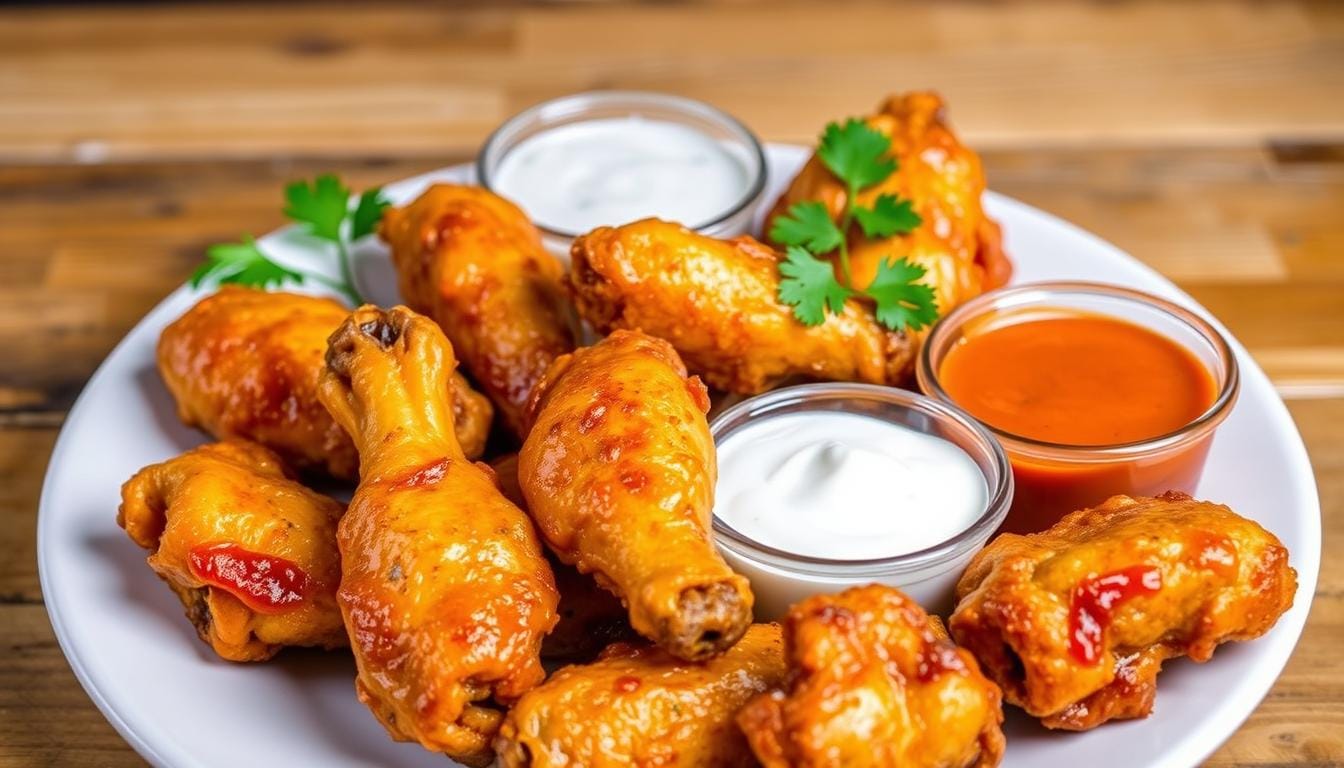
How to make boneless wings
I’ve included step-by-step photos below to make this recipe easy to follow at home. For the full printable recipe instructions and ingredient quantities, scroll to the recipe card at the bottom of this post.

Step 1- Prep: Whisk the dry ingredients in a bowl. In a separate bowl, whisk the eggs and milk together.

Step 2- Dredge: Dip each piece of chicken in the wet mix, then the flour mix, and repeat. Every wing should be double-coated.
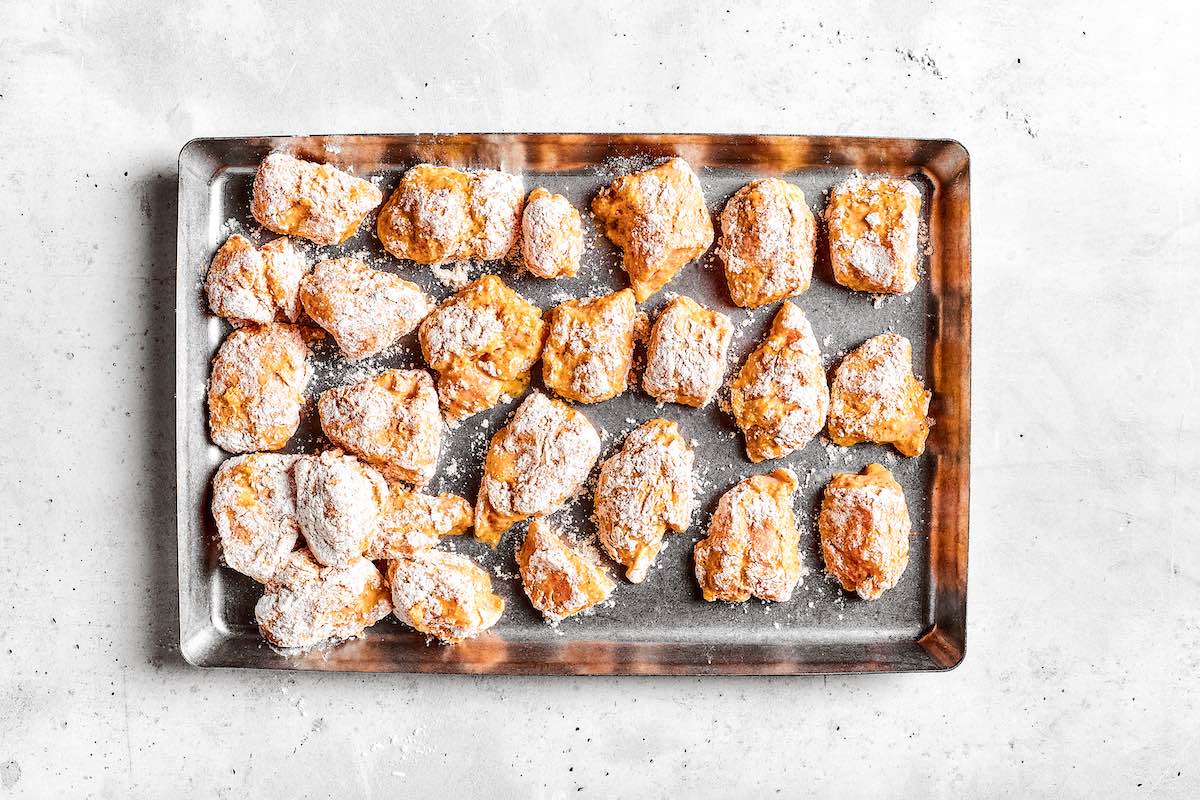
Step 3- Rest: Place the wings on a plate and set them aside to rest for at least 10 minutes.
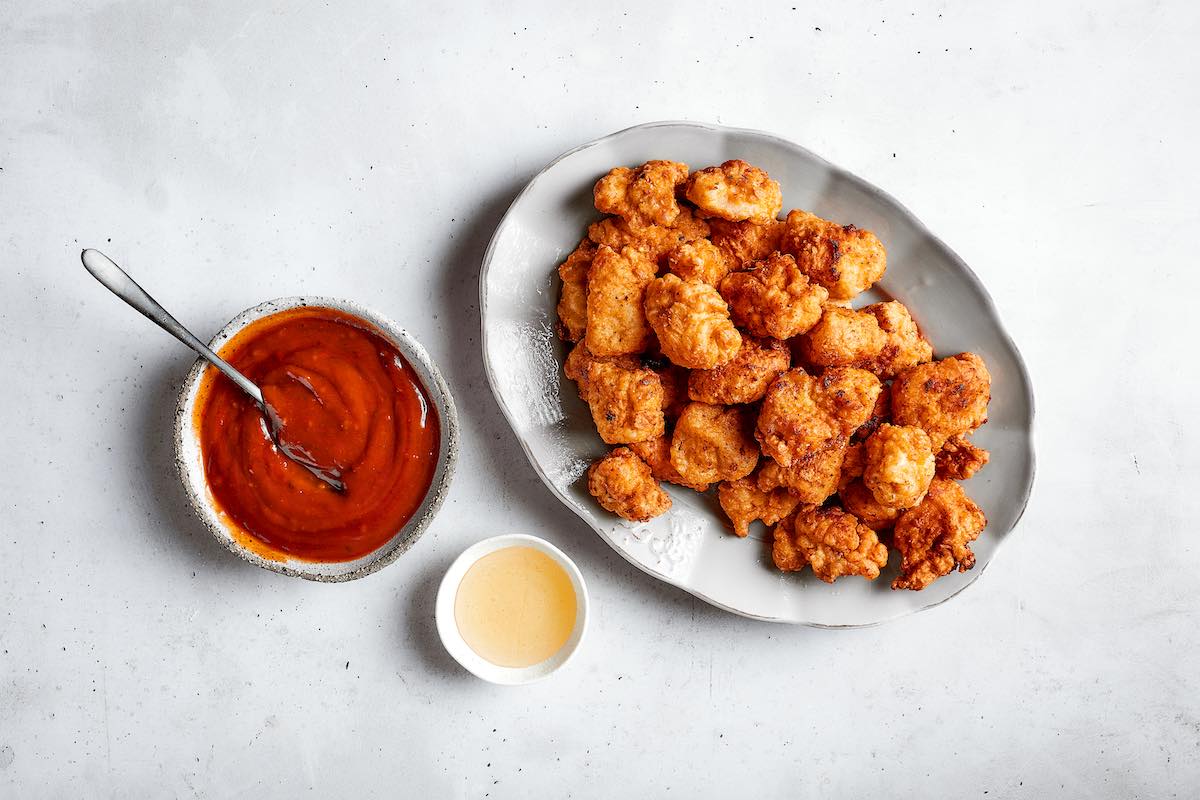
Step 4- Fry and sauce: Heat the oil in a large skillet over medium-high heat. Once it’s hot, fry the chicken wings in batches until they’re golden brown. Toss the chicken bites in the sauce, then serve immediately.
- You’ll know the chicken is fully cooked once it reaches an internal temperature of 165F. I suggest using a meat thermometer to double-check.
- Always double-coat the wings in the dredge! This gives them a thick and extra crispy crust around the outside.
- Rest the chicken before frying. This will dry them out slightly, giving you crispy and flavorful chicken wings.
- Customize the flavor with different spices in the flour dredge: Use any seasoning blend you like or any spice mix of choice. I love to use the same lemon pepper seasoning in my lemon pepper wings for that hint of lemon or even taco seasoning for a Mexican spin.
- Use different sauces: I mentioned it earlier, but my family loves all the different sauces we can use to change up the flavor. If you have a favorite, use that, or try some family favorites like hot honey sauce or bulgogi sauce.
- Add cheese: What makes buffalo wings taste even better? A sprinkling of crumbled blue cheese.
To store: The leftover chicken wings can be stored in an airtight container in the fridge for about 4 to 5 days.
To freeze: Once they’re fried and crispy, let the wings cool to room temperature and transfer them to a lined baking sheet. Freeze until solid, then transfer to an airtight container and freeze for up to 3 months.
To reheat: To retain the crisp exterior and juicy meat, reheat the wings in a 350ºF oven or air fryer until warmed through.
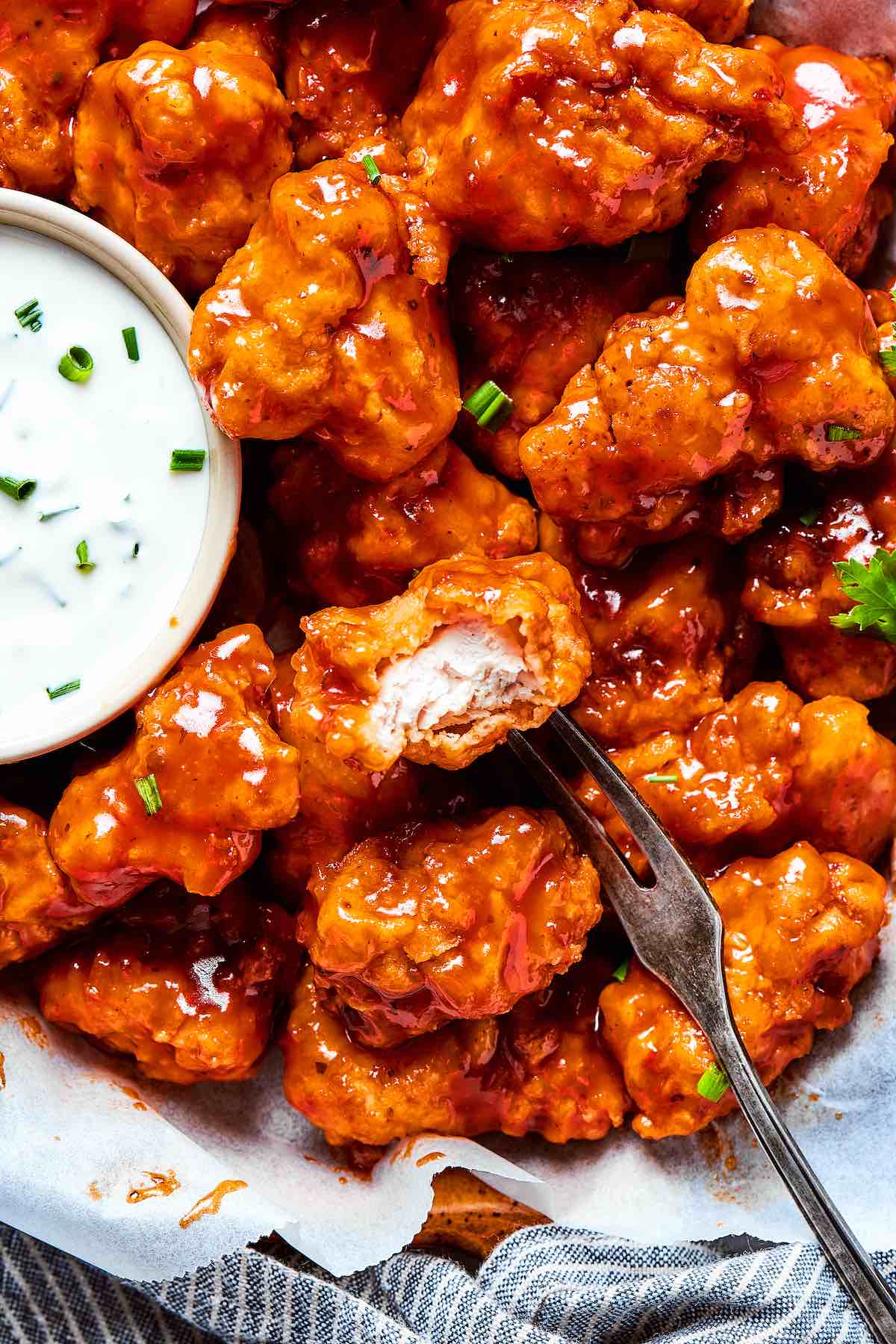
Yes! My recipe will work with frozen chicken breasts, but they’ll need to be thawed before slicing, dredging, and cooking. I also recommend patting them dry VERY carefully to make sure there is no excess moisture.
Absolutely. If you don’t want to use boneless chicken breasts, you can cut boneless chicken thighs or tenders into bite-sized pieces instead.
To air fry the boneless wings, dredge them as normal and spray them with cooking oil. Place them in a single layer in the air fryer, then cook at 375ºF for about 15 to 20 minutes or until their internal temperature reaches 165ºF, flipping halfway through. Toss the wings in the sauce of your choice when they’re done, then serve.
Why I love this recipe
- PERFECT texture. You get the crispy exterior and juicy interior but with a thicker bite than traditional wings.
- Kid and adult approved. This is the kind of appetizer that everyone, and I mean everyone adores.
- Easy to make into a meal. These wings are healthy enough to be part of a wholesome dinner as the main protein source. I like to add a simple salad and some potatoes and call it dinner!
- Flexible. To keep things interesting, I love to change up the sauce I toss them in. While buffalo is a classic, BBQ sauce and even an Asian sauce like eel sauce work so well, too!
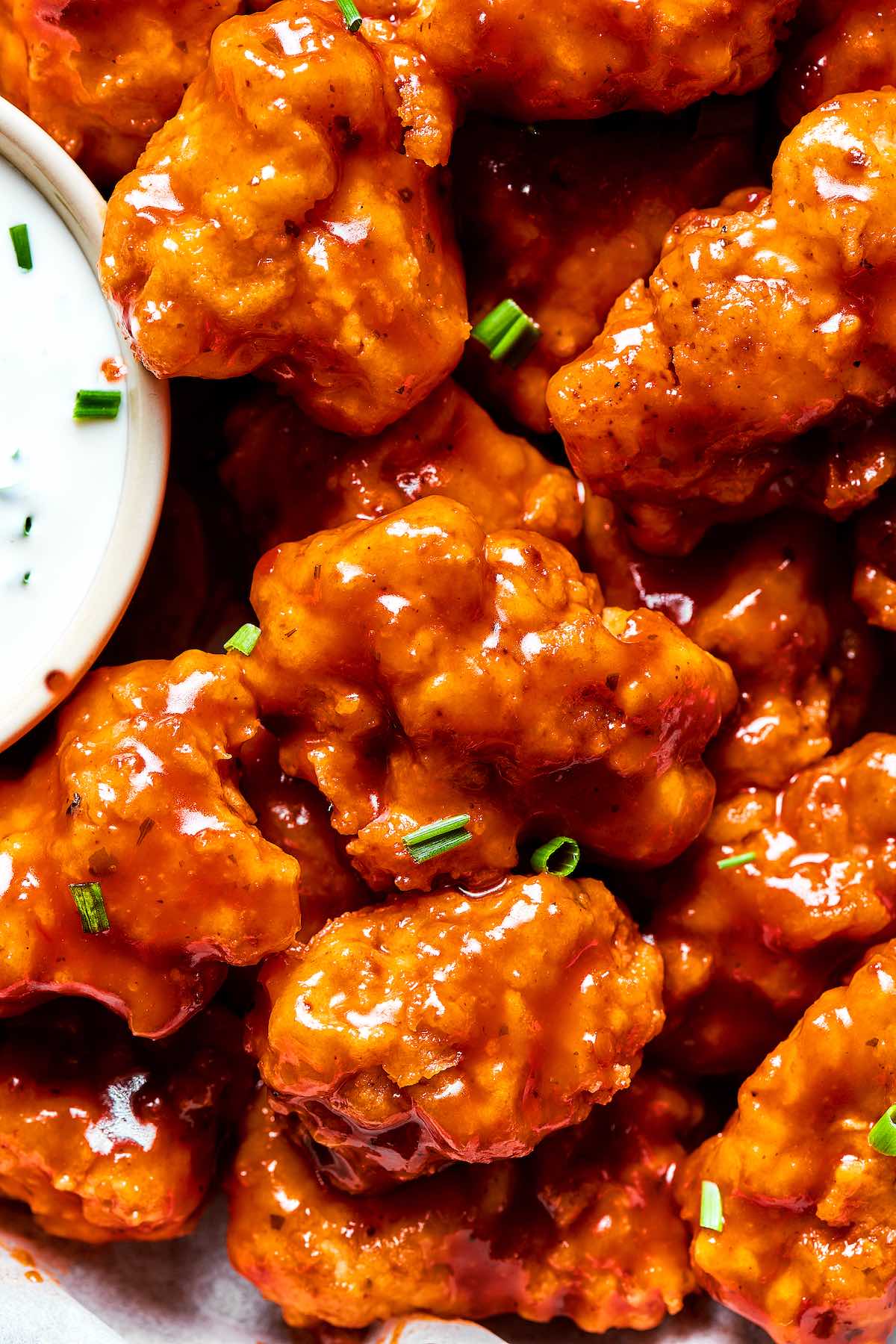
- Chicken breasts. Boneless and skinless chicken breasts are cut into bite-sized pieces to make the wings. If I’m short on time, I sometimes use chicken tenders or tenderloins and just cut them in half.
- Flour. A light coating of flour keeps the outside crispy while the inside juicy.
- Spices. Garlic powder, onion powder, paprika, cayenne, salt, and pepper.
- Eggs. Dredging the wings in egg wash helps the seasonings stick and helps to form a golden, crispy exterior.
- Milk. To help the spices and flour stick to the outside of the wings. You can use dairy free milk if you prefer.
- Vegetable oil. For frying.
- Sauce. I use a combination of buffalo sauce and honey. I find buffalo sauce on its own to be a little too overpowering, so mixing it with a liquid sweetener (honey here) makes it seriously drool-worthy!
DIY Boneless Buffalo Wings
FAQ
Are boneless chicken wings fried?
Boneless skinless chicken breast is usually sliced, breaded, and fried to make boneless chicken wings. They’re typically coated in a sauce, and are essentially chicken nuggets. Are Boneless Chicken Wings Healthier Than Bone-In Chicken Wings?
How do you make boneless chicken wings?
Chefs make boneless wings by cutting boneless, skinless chicken breasts into wing-sized pieces, breading or battering them, and then deep frying them until golden brown. While the boneless chicken wings most restaurants serve are not deboned chicken, that doesn’t mean you can’t set your menu apart by serving deboned chicken wings.
Are boneless chicken wings good?
Bite-sized chicken breasts are breaded, fried, and coated in buffalo sauce to make these my crispy boneless wings. They’re easy, fast, and better than any restaurant! Boneless chicken wings are the way to go when you want more bang for your chicken wing buck.
Are boneless chicken wings made from scratch?
Yes, this recipe makes boneless chicken wings from scratch. You’ll learn a foolproof technique for juicy, tender boneless chicken wings every time. Serve them however you like!
Why are boneless wings called chicken nuggets?
Boneless wings are often found in fast-food or fast-casual restaurants where the crisp-coated breast meat might otherwise be known as a nugget, finger, or tender. My best guess is that calling them boneless wings makes it more socially acceptable to get a grown-up to eat a chicken nugget.
Are boneless wings real wings?
Boneless wings are a happy hour menu staple, but if you pause long enough between crispy, juicy bites, you realize that a wing without a bone is an oxymoron. So, are boneless wings actually wings? Boneless wings are not chicken wings with their bones removed.
How are boneless wings made?
Boneless wings are made from pieces of skinless, boneless chicken breast or thigh meat that are cut into bite-sized pieces, coated in a batter or breading mixture, and then fried or baked until crispy. These pieces are subsequently tossed in Buffalo-style hot sauce, similar to how traditional chicken wings are prepared and served.
What makes chicken wings boneless?
So-called “boneless” chicken wings are not chicken wings at all. Boneless chicken wings are made from breast meat. The breast meat is removed from the bone and cut into a size and shape that resembles chicken wings.
Are boneless wings basically chicken nuggets?
Chicken nuggets are ground chicken formed into nugget shapes then breaded and fried. Boneless wings are chicken breasts cut into nugget size pieces, then breaded and fried. They are not the same.
